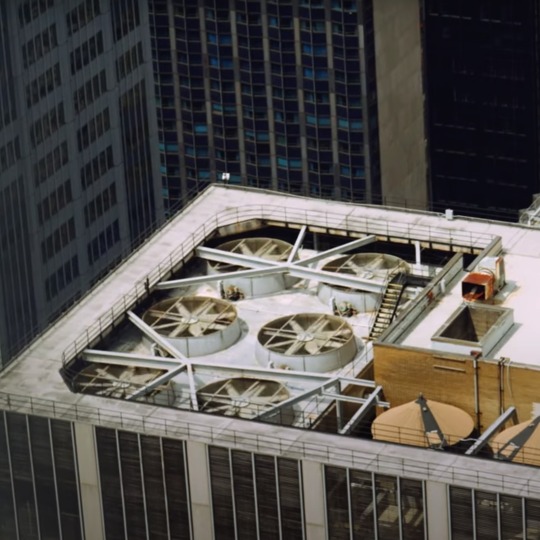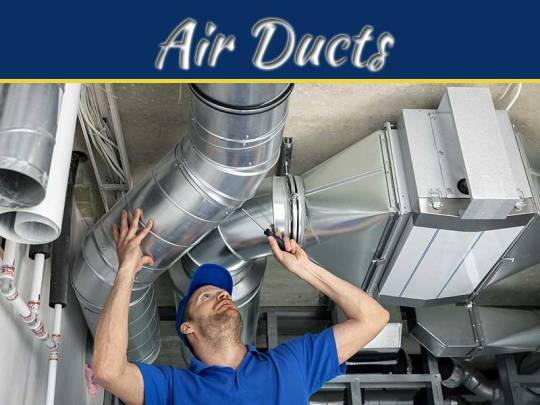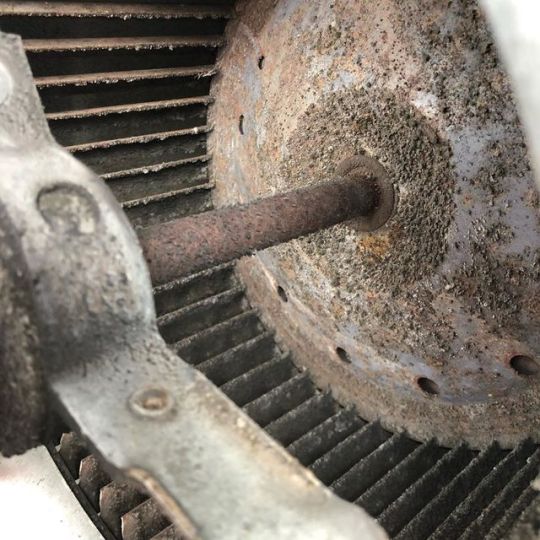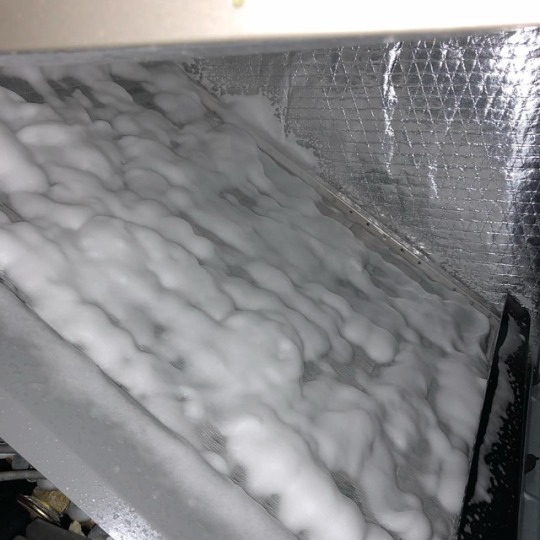#hvacefficiency
Explore tagged Tumblr posts
Text

🏢 Smarter Motor Control for Efficient Buildings ⚙️
From cooling towers and chiller pumps to large ventilation fans and booster systems, variable frequency drives (VFDs) deliver precise speed, torque, and power control essential for modern building automation. Designed for both variable and constant torque loads, VFDs dynamically adjust motor operation to match demand in real time, driving significant energy savings and reducing mechanical wear. Built-in features such as fire mode operation, BACnet and Modbus RTU communication, and advanced bypass integration for critical Direct-on-Line (DoL) switchover ensure reliable performance in even the most demanding applications.
With low harmonic design, quiet high-frequency switching, and built-in EMC filters, VFDs simplify installation and improve overall building performance. Whether you operate a residential high-rise, commercial complex, or mission-critical facility, variable frequency drives help achieve energy targets, lower costs, and maintain comfortable environments year-round.
The VFD Exchange
#buildingautomation#hvacefficiency#coolingtowers#vfdtechnology#invertek#drives#torque#speed#electrical#variablefrequencydrives#vfds#motorcontrols#hvac#fans#pumps
0 notes
Text
#ThermostatTips#RecoveryMode#SmartThermostat#HVACEfficiency#EnergySaving#HomeCooling#HeatingTips#EcoFriendlyLiving#SmartHome#ProgrammableThermostat#SaveOnEnergy#GreenLiving#HomeComfort#HVACMaintenance
1 note
·
View note
Text

Learn how thermostat recovery mode works and how to use it to save energy, increase comfort, and reduce HVAC costs. Whether you have a smart thermostat or a programmable one, these expert tips will help you optimize your heating and cooling system for maximum efficiency. Perfect for homeowners looking to stay eco-friendly and budget-conscious!
#ThermostatTips#RecoveryMode#SmartThermostat#HVACEfficiency#EnergySaving#HomeCooling#HeatingTips#EcoFriendlyLiving#SmartHome#ProgrammableThermostat#SaveOnEnergy#GreenLiving#HomeComfort#HVACMaintenance
0 notes
Text
High-Performance Insulation Materials Market Growth Fueled by Demand in Energy-Efficient Construction Applications
Introduction
The High-Performance Insulation Materials Market is witnessing significant growth, primarily driven by the rising emphasis on energy-efficient construction. With climate goals tightening and global energy prices fluctuating, builders and developers are turning to advanced insulation materials to meet stricter thermal performance standards while lowering carbon footprints.

Energy Efficiency: A Strategic Priority in Construction
Governments and environmental bodies across the world are mandating energy-efficient practices to address climate change and reduce energy dependency. Buildings account for nearly 40% of global energy consumption, a figure that has pushed energy efficiency to the forefront of construction strategies. High-performance insulation materials play a crucial role in lowering heating and cooling requirements.
Materials such as vacuum insulated panels (VIPs), polyurethane foams, aerogels, and structural insulated panels (SIPs) are increasingly specified in green buildings. Their superior thermal resistance and reduced thickness requirements make them attractive for retrofitting old buildings as well as designing new structures from the ground up.
Regulatory Push and Green Certification Systems
Legislation like the International Energy Conservation Code (IECC) and programs like Energy Star have accelerated the adoption of high-performance insulation. Moreover, green certification systems such as LEED and BREEAM give high ratings to projects incorporating sustainable insulation.
Developers aiming for high certification scores are prioritizing insulation materials with low thermal conductivity, long service life, and environmental safety. These certifications not only drive market demand but also push innovation within the insulation industry.
Technological Advancements in Material Science
Technology is a vital enabler in the evolution of insulation materials. Innovations in nanotechnology, for instance, are improving the R-value (thermal resistance) of materials without increasing their thickness. Aerogels, known for their extremely low thermal conductivity, are now available in flexible blanket forms, making them easier to install in buildings.
Vacuum insulated panels (VIPs) have also undergone improvements in durability and affordability, expanding their application from refrigeration and cold storage to residential and commercial buildings. Ongoing R&D is exploring biodegradable and recyclable alternatives that align with circular economy principles.
Market Penetration Across Residential and Commercial Segments
The demand for high-performance insulation is strong in both residential and commercial construction. In residential applications, homeowners seek reduced utility bills and comfortable indoor environments. In commercial properties, building managers look to improve energy efficiency to meet regulatory standards and ESG (Environmental, Social, Governance) benchmarks.
New-build construction dominates demand, but retrofitting older buildings with energy-efficient insulation is also gaining momentum, particularly in Europe and North America, where aging infrastructure is being upgraded to meet contemporary standards.
Key Regions Driving Market Growth
North America and Europe currently lead the global high-performance insulation materials market due to stringent regulations, high awareness, and the prevalence of energy certification systems. However, Asia-Pacific is expected to witness the fastest growth rate, fueled by rapid urbanization, smart city developments, and rising concerns about air conditioning energy usage.
In countries like China and India, government programs supporting energy-efficient housing and infrastructure have created fertile ground for market expansion. Japan and South Korea also stand out for integrating advanced insulation into earthquake-resilient and energy-compliant buildings.
Challenges in Market Adoption
Despite the promising growth trajectory, the market faces a few challenges. High initial costs of advanced insulation materials deter adoption in cost-sensitive markets. Additionally, installation complexities and the lack of skilled labor for handling some modern materials—like aerogels or VIPs—present operational hurdles.
However, industry stakeholders are responding by developing hybrid insulation systems that balance cost, performance, and ease of application. Increased focus on training construction professionals is also expected to ease adoption barriers in the future.
Future Outlook and Emerging Trends
Looking ahead, the market is poised for further evolution driven by sustainability trends, innovation, and energy mandates. Bio-based insulation products made from hemp, sheep wool, and recycled denim are gaining attention for their eco-friendly profiles. Similarly, smart insulation technologies that integrate thermal sensors and automatic modulation features are emerging on the innovation frontier.
Moreover, the rising popularity of prefabricated and modular buildings, which often integrate high-performance insulation during manufacturing, will also open new avenues of growth.
Conclusion
As global emphasis on energy efficiency and sustainability intensifies, the High-Performance Insulation Materials Market is positioned for sustained expansion. Regulatory backing, technological advancements, and demand from energy-conscious consumers are creating a robust environment for innovation and adoption. The future of construction—whether residential or commercial—will be built on the back of materials that deliver high thermal performance while minimizing environmental impact.
#InsulationTechnology#SustainableConstruction#GreenBuildingMaterials#Aerogels#EnergyEfficiency#BuildingInnovation#SmartCities#ConstructionMaterials#ThermalInsulation#EcoFriendlySolutions#GreenCertification#HVACEfficiency#Retrofitting#HighPerformanceMaterials
0 notes
Text
Automatic & Manual Balancing Valves – Diagram, Flow Chart & Price List Explained
Efficient hydronic balancing is critical in HVAC systems, and balancing valves are the solution. Whether you're managing flow in a chilled water line, hot water system, or industrial plant, using the correct manual or automatic balancing valve ensures optimal flow distribution, energy savings, and system reliability.
As a reputed manufacturer and supplier in Delhi, Udhhyog offers a wide range of manual and automatic balancing valves that suit modern plumbing and HVAC applications.
This article explores the types of balancing valves, their working mechanism, diagrams, flow charts, and current market prices to help you make the right choice.
What Are Balancing Valves?
A balancing valve ensures that each branch in a fluid distribution system gets its desired flow rate. These valves help maintain hydraulic balance, which is especially crucial in HVAC and hot/cold water supply systems.
There are two main categories:
Manual Balancing Valve: Manually adjusted to regulate flow.
Automatic Balancing Valve: Self-regulating valve that maintains flow irrespective of pressure changes.
Manual Balancing Valves – Overview
✅ Working Principle
Manual balancing valves operate by adjusting a handwheel or calibrated dial. The installer sets the valve to a specific position based on flow requirements.
✅ Applications
Chiller lines
Cooling towers
Terminal units in HVAC
Radiator circuits
✅ Advantages
Cost-effective
Simple to operate
Suitable for steady-state systems
Automatic Balancing Valves – Overview
✅ Working Principle
Automatic balancing valves use a spring-loaded diaphragm or cartridge to keep differential pressure constant. This maintains a fixed flow rate regardless of system pressure changes.
✅ Applications
High-rise buildings
Variable load HVAC systems
Systems with pressure fluctuations
✅ Advantages
No need for recalibration
Maintains consistent performance
Reduces energy consumption
Balancing Valve Diagram & Symbol
Manual Balancing Valve Diagram:
Shows inlet/outlet ports, measuring nipples, and adjustment knob
Automatic Balancing Valve Diagram:
Features internal spring/diaphragm and a pressure regulating unit
Balancing Valve Symbol:
Square box with internal lines and arrows indicating flow direction and function
These diagrams are used in engineering schematics and installation blueprints.
Balancing Valve Flow Chart – Step by Step
The flow chart for balancing valves helps in:
Determining design flow rate
Selecting valve size
Setting or calibrating (manual)
Pressure balancing (automatic)
Performance verification
This ensures that each branch receives its required flow, reducing complaints of overheating or undercooling.
Balancing Valve Types at Udhhyog
🔹 Manual Flow Control Balancing Valve
🔹 Automatic Flow Control Balancing Valve
🔹 Pressure Independent Balancing Valve (PIBV)
🔹 Digital/Smart Balancing Valve
🔹 Dual-Function (Combined control and balance)
We also supply:
Balanced Bellows Safety Relief Valve
Balanced Plug Valve
Balanced Safety Relief Valve
Balancing Valve Price List – Updated Delhi Market Rates
Valve TypeSize (mm)Price Range (INR)Manual Balancing Valve15–50₹850 – ₹2,500Automatic Balancing Valve20–80₹2,500 – ₹7,500Pressure Independent Valve25–100₹4,800 – ₹10,500Digital Balancing Valve25–150₹15,000 – ₹35,000Balanced Safety Relief Valve25–100₹6,000 – ₹15,000Balanced Plug Valve25–150₹8,000 – ₹18,000
📌 Prices vary based on material, pressure class, and valve make. Contact Udhhyog for custom rates.
Where Are Balancing Valves Used?
🏢 Commercial HVAC systems
🏠 Residential heating/cooling lines
🏭 Industrial process piping
🏥 Healthcare & pharma facilities
🏬 Shopping complexes and data centers
Why Choose Udhhyog – Top Balancing Valve Supplier in Delhi
🏭 Wide Product Range
From basic manual to smart automatic valves, we cover all types.
📈 Tested & Certified
Valves conform to ISO and IS standards and are pressure-tested.
🚛 Quick Delivery in North India
We supply across Delhi, Haryana, Punjab, J&K, UP, and Himachal Pradesh.
💡 Technical Support
We help with system design, valve sizing, and installation support.
💰 Affordable Pricing & Custom Orders
Get competitive rates, custom solutions, and bulk discounts.
Conclusion
Manual and automatic balancing valves both serve essential roles in HVAC and fluid systems. The right choice depends on flow conditions, system pressure, and design load variation.
Udhhyog is your trusted balancing valve supplier in Delhi with a full catalog of reliable, efficient, and affordable valve solutions.
Contact us today for help choosing the best valve for your project.
Contact Udhhyog
📞 Call Us or Visit Our Website to request a quote or technical catalog.
#BalancingValve#ManualBalancingValve#AutomaticBalancingValve#BalancedReliefValve#BalancedPlugValve#ValveSupplierDelhi#HVACEfficiency#Udhhyog#HydronicBalancing#PipingSolutions
0 notes
Text
Automatic & Manual Balancing Valves – Diagram, Flow Chart & Price List Explained
Efficient hydronic balancing is critical in HVAC systems, and balancing valves are the solution. Whether you're managing flow in a chilled water line, hot water system, or industrial plant, using the correct manual or automatic balancing valve ensures optimal flow distribution, energy savings, and system reliability.
As a reputed manufacturer and supplier in Delhi, Udhhyog offers a wide range of manual and automatic balancing valves that suit modern plumbing and HVAC applications.
This article explores the types of balancing valves, their working mechanism, diagrams, flow charts, and current market prices to help you make the right choice.
What Are Balancing Valves?
A balancing valve ensures that each branch in a fluid distribution system gets its desired flow rate. These valves help maintain hydraulic balance, which is especially crucial in HVAC and hot/cold water supply systems.
There are two main categories:
Manual Balancing Valve: Manually adjusted to regulate flow.
Automatic Balancing Valve: Self-regulating valve that maintains flow irrespective of pressure changes.
Manual Balancing Valves – Overview
✅ Working Principle
Manual balancing valves operate by adjusting a handwheel or calibrated dial. The installer sets the valve to a specific position based on flow requirements.
✅ Applications
Chiller lines
Cooling towers
Terminal units in HVAC
Radiator circuits
✅ Advantages
Cost-effective
Simple to operate
Suitable for steady-state systems
Automatic Balancing Valves – Overview
✅ Working Principle
Automatic balancing valves use a spring-loaded diaphragm or cartridge to keep differential pressure constant. This maintains a fixed flow rate regardless of system pressure changes.
✅ Applications
High-rise buildings
Variable load HVAC systems
Systems with pressure fluctuations
✅ Advantages
No need for recalibration
Maintains consistent performance
Reduces energy consumption
Balancing Valve Diagram & Symbol
Manual Balancing Valve Diagram:
Shows inlet/outlet ports, measuring nipples, and adjustment knob
Automatic Balancing Valve Diagram:
Features internal spring/diaphragm and a pressure regulating unit
Balancing Valve Symbol:
Square box with internal lines and arrows indicating flow direction and function
These diagrams are used in engineering schematics and installation blueprints.
Balancing Valve Flow Chart – Step by Step
The flow chart for balancing valves helps in:
Determining design flow rate
Selecting valve size
Setting or calibrating (manual)
Pressure balancing (automatic)
Performance verification
This ensures that each branch receives its required flow, reducing complaints of overheating or undercooling.
Balancing Valve Types at Udhhyog
🔹 Manual Flow Control Balancing Valve
🔹 Automatic Flow Control Balancing Valve
🔹 Pressure Independent Balancing Valve (PIBV)
🔹 Digital/Smart Balancing Valve
🔹 Dual-Function (Combined control and balance)
We also supply:
Balanced Bellows Safety Relief Valve
Balanced Plug Valve
Balanced Safety Relief Valve
Balancing Valve Price List – Updated Delhi Market Rates
Valve TypeSize (mm)Price Range (INR)Manual Balancing Valve15–50₹850 – ₹2,500Automatic Balancing Valve20–80₹2,500 – ₹7,500Pressure Independent Valve25–100₹4,800 – ₹10,500Digital Balancing Valve25–150₹15,000 – ₹35,000Balanced Safety Relief Valve25–100₹6,000 – ₹15,000Balanced Plug Valve25–150₹8,000 – ₹18,000
📌 Prices vary based on material, pressure class, and valve make. Contact Udhhyog for custom rates.
Where Are Balancing Valves Used?
🏢 Commercial HVAC systems
🏠 Residential heating/cooling lines
🏭 Industrial process piping
🏥 Healthcare & pharma facilities
🏬 Shopping complexes and data centers
Why Choose Udhhyog – Top Balancing Valve Supplier in Delhi
🏭 Wide Product Range
From basic manual to smart automatic valves, we cover all types.
📈 Tested & Certified
Valves conform to ISO and IS standards and are pressure-tested.
🚛 Quick Delivery in North India
We supply across Delhi, Haryana, Punjab, J&K, UP, and Himachal Pradesh.
💡 Technical Support
We help with system design, valve sizing, and installation support.
💰 Affordable Pricing & Custom Orders
Get competitive rates, custom solutions, and bulk discounts.
Conclusion
Manual and automatic balancing valves both serve essential roles in HVAC and fluid systems. The right choice depends on flow conditions, system pressure, and design load variation.
Udhhyog is your trusted balancing valve supplier in Delhi with a full catalog of reliable, efficient, and affordable valve solutions.
Contact us today for help choosing the best valve for your project.
Contact Udhhyog
📞 Call Us or Visit Our Website to request a quote or technical catalog.
#BalancingValve#ManualBalancingValve#AutomaticBalancingValve#BalancedReliefValve#BalancedPlugValve#ValveSupplierDelhi#HVACEfficiency#Udhhyog#HydronicBalancing#PipingSolutions
1 note
·
View note
Text
Automatic & Manual Balancing Valves – Diagram, Flow Chart & Price List Explained
Efficient hydronic balancing is critical in HVAC systems, and balancing valves are the solution. Whether you're managing flow in a chilled water line, hot water system, or industrial plant, using the correct manual or automatic balancing valve ensures optimal flow distribution, energy savings, and system reliability.
As a reputed manufacturer and supplier in Delhi, Udhhyog offers a wide range of manual and automatic balancing valves that suit modern plumbing and HVAC applications.
This article explores the types of balancing valves, their working mechanism, diagrams, flow charts, and current market prices to help you make the right choice.
What Are Balancing Valves?
A balancing valve ensures that each branch in a fluid distribution system gets its desired flow rate. These valves help maintain hydraulic balance, which is especially crucial in HVAC and hot/cold water supply systems.
There are two main categories:
Manual Balancing Valve: Manually adjusted to regulate flow.
Automatic Balancing Valve: Self-regulating valve that maintains flow irrespective of pressure changes.
Manual Balancing Valves – Overview
✅ Working Principle
Manual balancing valves operate by adjusting a handwheel or calibrated dial. The installer sets the valve to a specific position based on flow requirements.
✅ Applications
Chiller lines
Cooling towers
Terminal units in HVAC
Radiator circuits
✅ Advantages
Cost-effective
Simple to operate
Suitable for steady-state systems
Automatic Balancing Valves – Overview
✅ Working Principle
Automatic balancing valves use a spring-loaded diaphragm or cartridge to keep differential pressure constant. This maintains a fixed flow rate regardless of system pressure changes.
✅ Applications
High-rise buildings
Variable load HVAC systems
Systems with pressure fluctuations
✅ Advantages
No need for recalibration
Maintains consistent performance
Reduces energy consumption
Balancing Valve Diagram & Symbol
Manual Balancing Valve Diagram:
Shows inlet/outlet ports, measuring nipples, and adjustment knob
Automatic Balancing Valve Diagram:
Features internal spring/diaphragm and a pressure regulating unit
Balancing Valve Symbol:
Square box with internal lines and arrows indicating flow direction and function
These diagrams are used in engineering schematics and installation blueprints.
Balancing Valve Flow Chart – Step by Step
The flow chart for balancing valves helps in:
Determining design flow rate
Selecting valve size
Setting or calibrating (manual)
Pressure balancing (automatic)
Performance verification
This ensures that each branch receives its required flow, reducing complaints of overheating or undercooling.
Balancing Valve Types at Udhhyog
🔹 Manual Flow Control Balancing Valve
🔹 Automatic Flow Control Balancing Valve
🔹 Pressure Independent Balancing Valve (PIBV)
🔹 Digital/Smart Balancing Valve
🔹 Dual-Function (Combined control and balance)
We also supply:
Balanced Bellows Safety Relief Valve
Balanced Plug Valve
Balanced Safety Relief Valve
Balancing Valve Price List – Updated Delhi Market Rates
Valve TypeSize (mm)Price Range (INR)Manual Balancing Valve15–50₹850 – ₹2,500Automatic Balancing Valve20–80₹2,500 – ₹7,500Pressure Independent Valve25–100₹4,800 – ₹10,500Digital Balancing Valve25–150₹15,000 – ₹35,000Balanced Safety Relief Valve25–100₹6,000 – ₹15,000Balanced Plug Valve25–150₹8,000 – ₹18,000
📌 Prices vary based on material, pressure class, and valve make. Contact Udhhyog for custom rates.
Where Are Balancing Valves Used?
🏢 Commercial HVAC systems
🏠 Residential heating/cooling lines
🏭 Industrial process piping
🏥 Healthcare & pharma facilities
🏬 Shopping complexes and data centers
Why Choose Udhhyog – Top Balancing Valve Supplier in Delhi
🏭 Wide Product Range
From basic manual to smart automatic valves, we cover all types.
📈 Tested & Certified
Valves conform to ISO and IS standards and are pressure-tested.
🚛 Quick Delivery in North India
We supply across Delhi, Haryana, Punjab, J&K, UP, and Himachal Pradesh.
💡 Technical Support
We help with system design, valve sizing, and installation support.
💰 Affordable Pricing & Custom Orders
Get competitive rates, custom solutions, and bulk discounts.
Conclusion
Manual and automatic balancing valves both serve essential roles in HVAC and fluid systems. The right choice depends on flow conditions, system pressure, and design load variation.
Udhhyog is your trusted balancing valve supplier in Delhi with a full catalog of reliable, efficient, and affordable valve solutions.
Contact us today for help choosing the best valve for your project.
Contact Udhhyog
📞 Call Us or Visit Our Website to request a quote or technical catalog.
#BalancingValve#ManualBalancingValve#AutomaticBalancingValve#BalancedReliefValve#BalancedPlugValve#ValveSupplierDelhi#HVACEfficiency#Udhhyog#HydronicBalancing#PipingSolutions
0 notes
Text

🏠 Eliminate Indoor Allergens with Air Duct Cleaning! 🌿🌬
If you suffer from allergies or asthma, Eagle Air Duct Cleaning can help improve your indoor air quality!
✅ Allergen & Dust Removal
✅ Pet Dander & Pollen Elimination
✅ Cleaner, Fresher Air
✅ HVAC System Efficiency Boost
✅ Dryer Vent Cleaning for Extra Safety
📞 Call 855-640-0404 NOW to schedule your service!
🏠 Say goodbye to indoor allergens—breathe fresh air today!
#EagleAirDuctCleaning #AllergyRelief #CleanerHome #BreatheBetter #HVACEfficiency
0 notes
Photo

Air Ducts: The Impact On Indoor Air Quality
Air ducts play a vital role in the indoor air quality of homes, buildings, and businesses. Regular cleaning of air ducts can go a long way in preventing dust, allergens, and contaminants from entering your indoor air, thus improving air quality and the health of those in it.
1 note
·
View note
Text

❄️ Drive Maximum Efficiency in Refrigeration & HVAC Systems ❄️
Variable frequency drives are transforming compressor, pump, and fan applications, delivering precise control of motor speed, torque, and power consumption across refrigeration and HVAC systems. By continuously modulating compressor speed to match real-time cooling demand, VFDs improve system performance, extend equipment life, and achieve significant energy savings. With features such as soft start, configurable start-up profiles, and wide-speed operating ranges, they reduce wear and improve temperature stability in chillers, heat pumps, and condensing units.
Supporting induction, permanent magnet, and BLDC motors, Invertek Drives Coolvert series offers compatibility with high-efficiency rotary and scroll compressors, along with integrated crankcase heating, oil return cycles, and advanced safety protections. These VFDs also ensure compliance with stringent EMC standards and feature Safe Torque Off (SIL3), low harmonic emissions, and precise modulation up to 500 Hz output frequency.
Whether for commercial refrigeration, industrial chillers, or high-efficiency HVAC systems, variable frequency drives deliver the performance and reliability to keep operations efficient and cost-effective.
The VFD Exchange
#hvacefficiency#refrigerationsolutions#vfdtechnology#variablefrequencydrives#invertek#vfds#compressors#controls
0 notes
Photo

Cleaning unit for local business. Outdoor coil didn’t look bad, but this inside needed some attention big time. #hvacservice #hvacservices #hvacefficiency #airoutlookinc (at Huntsville, Alabama) https://www.instagram.com/p/Bxk9mPvFfTx/?igshid=ex4bgpusq5un
0 notes
Link
Learn about heating and cooling mistakes that can cost you big time on your energy bills.
0 notes
Link
Learn why you need to clean your dirty air filters.
0 notes
Link
Find out five tips for running an efficient heating and cooling system.
0 notes
Photo

Coil cleaner in action on inside and outside coils. One of our yearly services to help efficiency of your heating & air conditioning #techplustwo #coilcleaning #hvacservice #hvacefficiency #hvacquality (at Madison, Alabama) https://www.instagram.com/p/Bn3yGV2B_7N/?utm_source=ig_tumblr_share&igshid=1bxixgoq59h9p
0 notes
Link
Learn how to improve your HVAC's efficiency and save money.
0 notes